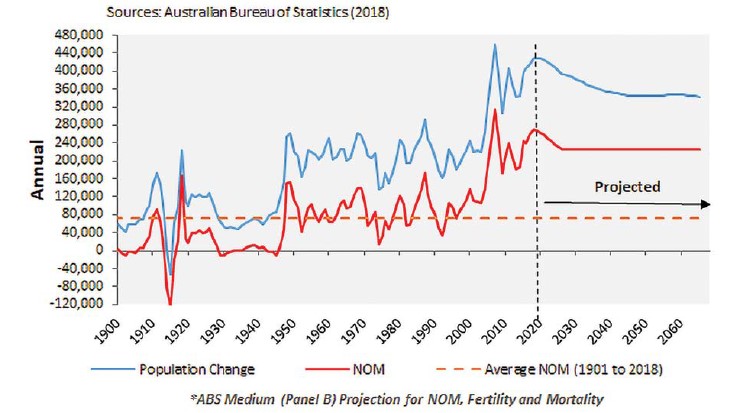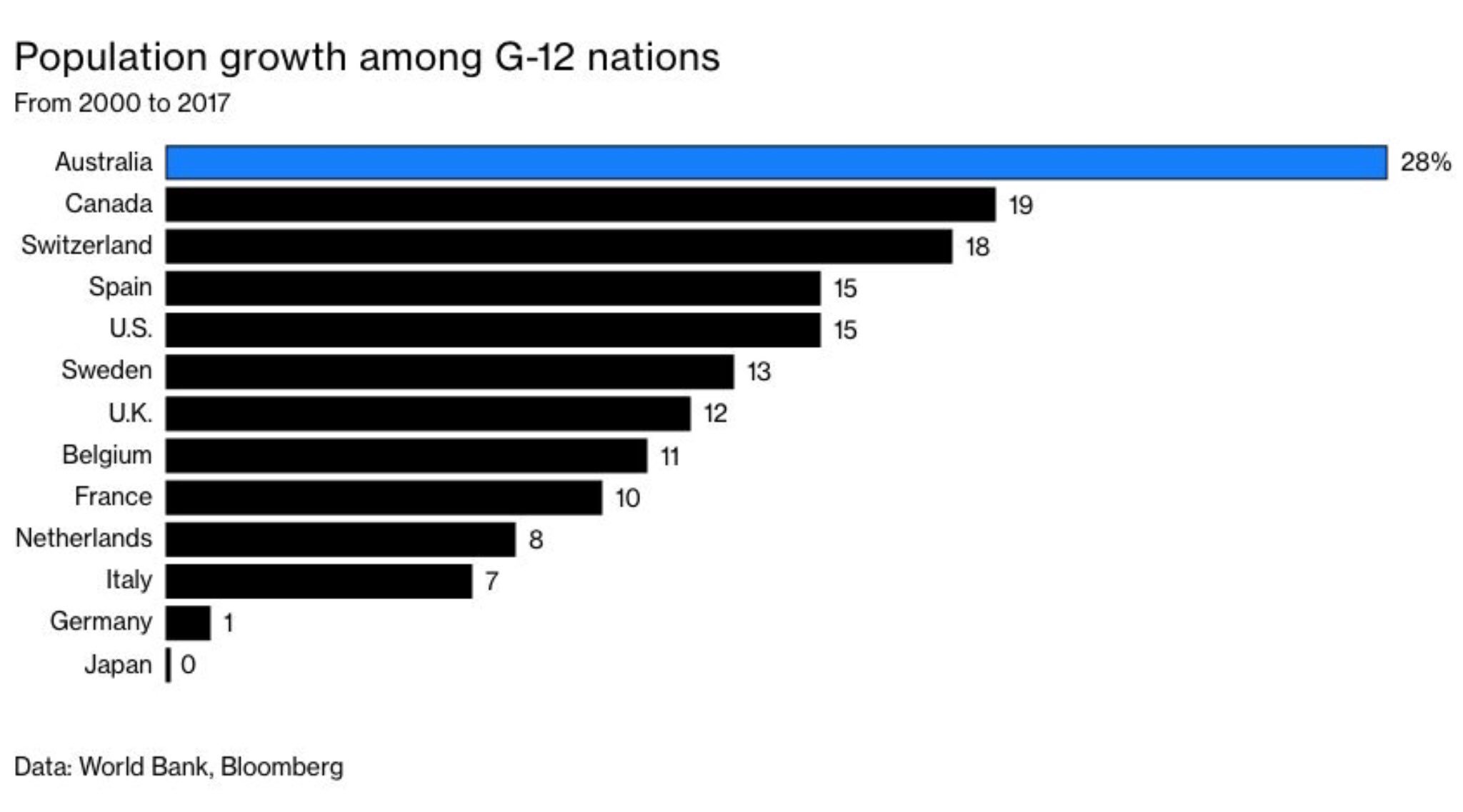Australian politicians never tire of telling the public how they are investing record amounts in infrastructure. Barely a day goes by without a minister announcing a new "congestion busting" infrastructure project designed to ease bottlenecks in Australian cities. Malcolm Turnbull said he wanted to be known as an "infrastructure prime minister". His predecessor, Tony Abbott, sought the same title. The current government under Scott Morrison has been widely touting its $100 billion infrastructure pipeline since its last budget.
Yet, even with the hundreds of billions of dollars sunk into new projects, infrastructure supply has not caught up with demand. No matter how much we borrow and build, Australia continues to resemble a dog chasing its own tail when it comes to infrastructure provision. And, as a new report argues, the infrastructure shortfall will only worsen - unless Australia's extraordinary rate of population growth is substantially reduced.
Launched in November by former New South Wales Premier Bob Carr on behalf of Sustainable Population Australia, the report - entitled "Population Growth and Infrastructure in Australia: The Catch-Up Illusion" - shows that sustained rapid population growth is resulting in a massive and growing infrastructure backlog, particularly in our largest cities. Consequently, the living standards of existing residents are being significantly eroded through intensifying congestion, growing infrastructure costs (e.g. toll roads and water), declining housing affordability, environmental degradation, and overall reduced amenity.
Advertisement
It is important to understand the nature and scale of the population problem. Australia's population is expanding by around 400,000 people annually - the equivalent of adding another Canberra-worth of people every 12 months or, to put it another way, the entire population of East Timor or Estonia every three years. According to the ABS, Australia gains an extra person every 1 minute and 23 seconds. Immigration is driving more than 60 percent of this population growth. As shown below, net overseas migration (NOM) numbers surged from the early-2000s, with the current immigration intake around three times the historical average.

Australia has long had a higher per capita immigration rate than comparable developed countries but the escalation in recent times is truly stupefying. Australia is currently in the midst of an immigration-fed population expansion that is both unprecedented in Australia's history and unrivalled in the developed world. The graphic below demonstrates just how abnormal Australia's population growth has been compared to that of other developed countries.

If allowed to continue at present rates, immigration will cause Australia's population to explode from 25.5 million to around 43 million over the next four-and-a-half decades. Sydney's population will swell to 9.7 million, while Melbourne will be an Asian-style megacity of 10.2 million. Both will have populations comparable in size to Australia's total population in the 1950s.
In The Catch-up Illusion, authors Leith van Onselen, Jane O'Sullivan and Peter G Cook assert that no amount of decentralisation, planning or investment will allow infrastructure to keep up with such manic population growth. They convincingly debunk the myth peddled by the Morrison Government that sending migrants to the bush is a solution to our mounting population pressures. Migrants may temporarily settle in regional areas to satisfy visa requirements but tend to gravitate toward the major cities once they have secured residency. This trend is clear in recent migrant settlement patterns.
Advertisement
Scott Morrison himself dismissed the idea of decentralisation as a realistic fix back in 2010 when he was in opposition, stating: "…to hold out some false hope that this problem's going to be solved because a Population Minister is going to fantastically move people around like has never been done before in our history, is I think unfair to the Australian people to suggest that that is realistic option, certainly in the short or medium term." Of course, Morrison has since changed his tune on decentralisation and evidently now expects Australians to believe that his government will succeed where all others have failed.
Even if meaningful decentralisation could be achieved, it would not ease the burden of delivering sufficient new infrastructure. With many regional areas already lacking adequate infrastructure, industry, jobs and even water, funnelling millions more people into regional cities and towns is likely to end in tears and misery.
The claims that Australia just needs to "plan better" and invest more in infrastructure are regularly made by Big Australia enthusiasts. However, as the Sustainable Population Australia report makes clear, the cost of providing new infrastructure across Australia's already built-out cities is prohibitive due to dis-economies of scale and the constantly moving target of a rapidly expanding population.
It is estimated that each new person added to the population requires well over $100,000 of public infrastructure to enjoy the same standard provided to incumbent residents. Thus, the cost of adding a new Canberra-worth of people every year easily runs into the tens of billions of dollars.
In Australia's already sprawling major cities, the cost of retrofitting is eye-wateringly expensive because of the need for tunnelling and land buy-backs and the disruption to existing infrastructure. Take, for example, Melbourne's West Gate Tunnel which is expected to cost $6.7 billion for five kilometres of highway. Per lane-kilometre, this will be 42 times more expensive than the Woolgoolga-Ballina highway upgrade project in New South Wales.
The evidence is clear: Australia is abjectly failing to build sufficient economic and social infrastructure to cater for rapid population growth caused primarily by 15 years of hyper immigration. Infrastructure Australia concluded in 2013 that the infrastructure deficit was already then at around $300 billion. As more people flood into our major cities, the cost and complexity of providing additional infrastructure will continue to increase substantially. The Productivity Commission noted in 2016 that such costs "will inevitably be borne by the Australian community either through user-pays fees or general taxation…"
Existing residents are also being forced to endure greater congestion and longer commute times, more expensive and smaller housing, longer hospital queues, more competition for school places, lower wages, and the rapid transformation of their communities into places they no longer recognise. The deliberate addition of millions more people will also severely hamper Australia's ability to meet its carbon emissions reduction targets, place more pressure on already stressed ecosystems and native habitats, and further dilute our natural resources.
Recent polls by Newspoll, Essential, the Lowy Institute, the Centre for Independent Studies, the ANU and the Australian Population Research Institute show that Australians are increasingly fed up with extremely high immigration and attendant population growth. In each survey, a majority of respondents wanted a decrease in immigration. Yet the major political parties remain hooked on Big Australia mass immigration and refuse to allow an honest debate about population numbers.
The Australian Population Research Institute's Bob Birrell and Katharine Betts have observed that the prevailing view among Australian elites is that all is well with their high immigration experiment. When confronted with concerns, the major political parties, large sections of the media and those with a vested commercial interest in high immigration – property developers, retailers, the universities, employers seeking cheap labour and other members of the 'growth lobby' – claim that running a pedal-to-the-metal immigration program is good for economic growth and thus for the betterment of the country. It is conveniently ignored that while adding more people might make the economy bigger, it does not make Australians richer per head. Although rarely mentioned among the Australian commentariat, the enormous expansion in immigration numbers has coincided with a collapse in real per capita household income growth.
Van Onselen, O'Sullivan and Cook observe the irony in the fact that the staggering infrastructure costs associated with population growth are:
…counted as additions to economic growth (additions to GDP), yet are unlikely to translate into benefits of improved per capita income or well-being for the existing population. Rather, they get passed down the line to residents in the form of extra charges and the lived experience of congestion and reduced amenity.
Until Australians make more of an effort to hold their political leaders to account over forced population growth, the infrastructure deficit will only widen and life in our cities will only get worse.